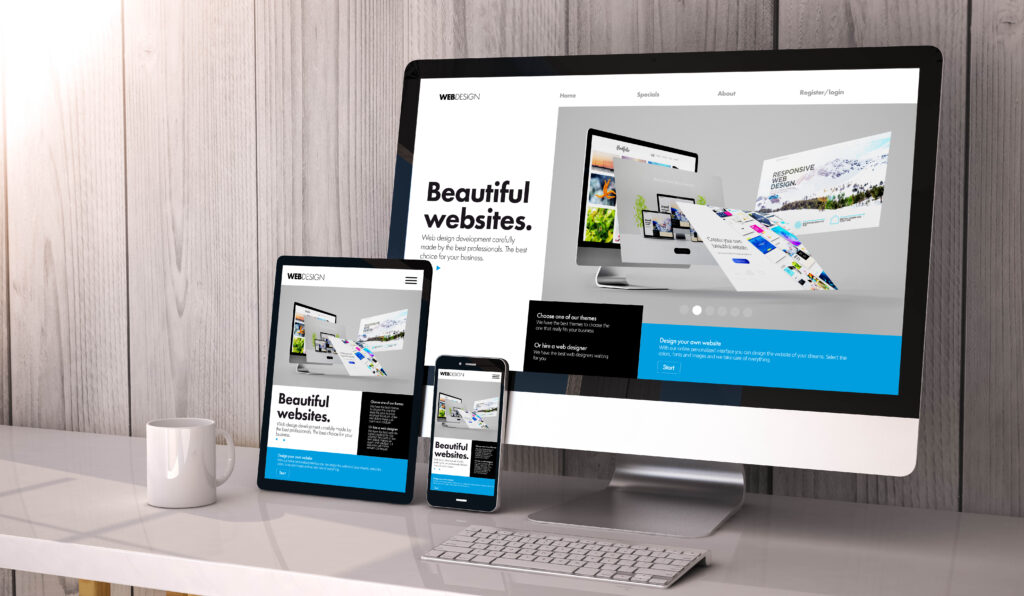Crafting a Website
Building a website might initially appear to be a complex task, but with clear guidance, it can become an enjoyable and productive endeavour. Websites serve various purposes, from personal blogs and online portfolios to comprehensive business sites and e-commerce platforms. Understanding the fundamental steps involved is crucial to ensure your project proceeds smoothly and efficiently.
One of the first decisions to make is the type of website you need. This will significantly influence subsequent steps, including design, content, and functionality. A business website, for instance, will have different requirements compared to a personal blog or portfolio.
Having a clear vision of your website’s purpose is essential. This vision will help guide your choices in design, content, and overall structure. Think about the primary goal of your site and the needs of your target audience. Is the website meant to inform, entertain, sell products, or offer services? Knowing this will help in making design and content decisions that resonate with your audience.
The selection of a domain name and hosting provider are equally important early steps. A domain name represents your site’s address on the internet and should be both memorable and reflective of your brand. Hosting, on the other hand, is the service that allows your website to be accessible online. Research different hosting options and choose one that offers reliability, support, and scalability to accommodate your website’s growth.
In the process of creating your site, utilising a website builder can be particularly helpful, especially for those without advanced technical skills. Website builders provide tools that simplify design and development, allowing you to focus more on content and user experience. By following a structured approach, you can efficiently create a website that is both functional and visually appealing.
Step 1: Establish Your Website’s Objective
Identifying the primary aim of your website is paramount before diving into its creation. Whether you intend to sell products, share insightful information, or provide a specific service, your site’s purpose will fundamentally shape its design and functionality. For example, an e-commerce site will require features such as product listings, shopping carts, and secure payment gateways, whereas a blog will focus more on content organisation and ease of reading.
Equally important is pinpointing your target audience. Understanding who you are trying to reach will influence everything from your site’s tone and style to the types of content you produce. For instance, a website aimed at professionals in a particular industry will differ significantly in design and content from one geared towards young, casual readers.
It can be helpful to create a detailed profile of your ideal visitor. Consider their demographics, interests, and online behaviour. This will not only guide your design choices but also help you develop content that resonates with your audience. Think about the kind of experience you want to offer and how you can meet your visitors’ needs effectively.
Another aspect to consider is your website’s long-term goals. Are you aiming to build a community, generate leads, or perhaps expand your brand’s reach? Having a clear vision of what you hope to achieve will help you stay focused and make informed decisions throughout the development process.
Lastly, bear in mind the importance of setting measurable objectives. Whether it’s the number of monthly visitors, sales targets, or engagement metrics, having clear goals will allow you to track your progress and adjust your strategy as needed.
Step 2: Select a Domain Name
A domain name is a critical element of your website’s identity and can have a significant impact on your online presence. Aim to choose a domain name that is short, easy to spell, and memorable. This will make it easier for visitors to find and remember your site. It’s also advisable to avoid using numbers and hyphens, as these can often be confusing when people are trying to recall your web address.
Conduct a thorough search to ensure that your chosen domain name is unique and not already in use. This can be done through domain registration platforms which will indicate availability and sometimes even suggest alternatives if your first choice is taken. It’s also wise to check for any existing trademarks to avoid potential legal issues.
Consider using a domain extension that aligns with your website’s purpose. While .com is the most popular and widely recognised, there are many other extensions available such as .org for organisations, .net for network-based services, and even more specific ones like .shop or .blog. Your choice of extension can add another layer of meaning to your domain name.
Additionally, think about the future growth of your website when selecting your domain. A name that is too niche might limit your expansion opportunities. Conversely, a more general name can give you the flexibility to diversify your offerings later on.
Finally, securing variations of your chosen domain name can be a smart move. This can help prevent competitors from registering similar names and protect your brand. For example, if you select example.com, you might also consider registering example.net or example.org. This strategy can be particularly useful if you plan to establish a strong online presence and wish to safeguard your brand.
Step 3: Pick a Hosting Provider
Selecting the right hosting provider is a crucial step in ensuring your website runs smoothly and efficiently. Begin by evaluating your website’s specific needs, including the expected traffic, the type of content you will be hosting, and any special requirements you might have, such as e-commerce capabilities or large storage needs.
When researching hosting providers, consider their uptime guarantees. Uptime refers to the amount of time your website is online and accessible to visitors. Look for providers that offer at least a 99.9% uptime guarantee to minimise any potential disruptions.
Customer support is another critical factor. Opt for a provider that offers 24/7 support through various channels, such as live chat, email, or phone. This ensures that you can quickly resolve any issues that may arise, keeping your website operational and your visitors satisfied.
Pricing is, of course, a significant consideration. Hosting packages can vary widely in cost, so compare the features offered in different plans. Some providers might offer attractive introductory rates that increase upon renewal, so be sure to read the fine print.
Additionally, consider the scalability of the hosting provider. As your website grows, you may need more resources, such as increased bandwidth or additional storage. Choose a provider that can easily scale with your needs, allowing you to upgrade your plan without major disruptions.
Security features are equally important. Ensure the provider offers robust security measures, such as SSL certificates, regular backups, and protection against DDoS attacks. These features help safeguard your website and its data, providing peace of mind.
Lastly, read reviews and testimonials from other users to get an idea of the provider’s reliability and overall performance. This can offer valuable insights and help you make an informed decision.
Step 4: Opt for a Website Builder
Utilising a website builder can greatly simplify the process of creating your site, particularly for those who are new to web development. Website builders like Wix are incredibly popular in regions such as Indonesia, Singapore, and Malaysia due to their ease of use and powerful features with Wix holding a significant market share in these countries as of December 2020.
When choosing a website builder, consider its features and capabilities. Look for templates that match the aesthetic you envision for your site. Templates serve as a starting point and can be customised to suit your needs, saving you time and effort. Drag-and-drop functionality is another key feature that simplifies the design process. This allows you to arrange elements such as text, images, and videos on your webpage without needing to write any code.
Customisation options are also important. A good website builder will offer a range of tools to adjust fonts, colours, and layouts, enabling you to create a unique look that aligns with your brand. Additionally, ensure the builder supports responsive design so your site looks good on both desktop and mobile devices.
Most website builders offer integrated SEO tools, making it easier to optimise your site for search engines. This includes features like meta tag editing, keyword integration, and performance analytics. Some builders also offer e-commerce capabilities, which can be particularly useful if you plan to sell products or services online.
Lastly, explore the support and resources provided. Many website builders offer tutorials, forums, and customer support to assist you in the creation process.
Step 5: Design Your Website’s Layout
A well-crafted layout is vital for an engaging user experience and effective site navigation. Start by selecting a layout that complements your website’s purpose and aesthetic. Most website builders offer a variety of pre-designed templates, which you can customise to suit your needs. Focus on simplicity and clarity, ensuring that your layout is not cluttered and that key information is easily accessible.
Consider the user journey through your site. Place essential elements such as the navigation bar, call-to-action buttons, and contact information in prominent locations. The navigation bar should be intuitive, allowing users to find what they are looking for with minimal effort. Group related content together and use headings and subheadings to break up text, making it easier to read.
Pay attention to visual hierarchy. Use different font sizes, colours, and weights to highlight important information and guide users’ attention. Consistency is key, so maintain a uniform style across all pages, including font types, colour schemes, and button styles. This helps in creating a cohesive and professional look.
Ensure your design is responsive, meaning it adapts seamlessly to different devices and screen sizes. Mobile traffic accounts for a significant portion of website visits, so your site must be user-friendly on smartphones and tablets. Test the layout on various devices to ensure a smooth experience for all users.
Incorporate multimedia elements like images and videos thoughtfully. High-quality visuals can enhance your site’s appeal, but they should not overwhelm or distract from the main content. Use white space effectively to create a clean and organised appearance, allowing your content to breathe and making it more digestible.
Step 6: Develop Content
Creating compelling content is pivotal to the success of your website. Start by identifying the type of content that will best serve your audience and align with your website’s purpose. This could range from informative blog posts and engaging multimedia to detailed product descriptions and customer testimonials. Aim to provide valuable information that addresses the needs and interests of your visitors.
Begin with a content plan outlining the topics you will cover and the formats you will use. Consistency is key, so establish a regular posting schedule to keep your audience engaged and returning for more. Quality should always take precedence over quantity; it’s better to have fewer, well-crafted pieces than a plethora of mediocre ones.
When writing, focus on clarity and readability. Break up large blocks of text with headings, bullet points, and images to make the content more digestible. Use an approachable and conversational tone that resonates with your audience, and avoid jargon unless your site caters to a specialised niche.
Incorporate a variety of media to enrich your content. High-quality images, videos, and infographics can make your site more visually appealing and help convey information more effectively. Ensure all multimedia elements are optimised for quick loading times to maintain a smooth user experience.
Encourage interaction by including calls-to-action, comment sections, and social media sharing options. Engaging your audience in this way can foster a sense of community and encourage repeat visits. Regularly update your content to keep it fresh and relevant, and stay attuned to feedback to continually improve your offerings.
Finally, ensure your content is original and free from plagiarism. Unique, high-quality content not only enhances user experience but also boosts your site’s credibility and SEO performance.
Step 7: Optimise for SEO
To enhance your website’s search engine rankings, implementing effective SEO strategies is essential. Start by conducting keyword research to identify terms and phrases that your target audience is searching for. Integrate these keywords naturally throughout your content, including in headings, subheadings, and image alt text, without overloading them.
Ensure your meta descriptions are concise and compelling, as they appear in search results and can influence click-through rates. Crafting unique meta descriptions for each page can help improve visibility and attract more visitors. Additionally, optimising your title tags with relevant keywords can significantly impact your site’s search engine performance.
A fast-loading website not only provides a better user experience but is also favoured by search engines. Compress images, leverage browser caching, and minimise the use of heavy scripts to enhance loading times. Tools like Google PageSpeed Insights can offer valuable suggestions for improvements.
Another critical aspect is ensuring your site is mobile-friendly. With a significant portion of users accessing websites via mobile devices, a responsive design that adapts to different screen sizes is vital. Search engines prioritise mobile-friendly sites, making this an important factor for SEO.
Building high-quality backlinks from reputable sources can also boost your site’s credibility and improve rankings. Engage in guest blogging, collaborate with influencers, and share your content on social media to attract inbound links.
Finally, regularly update your content to keep it fresh and relevant. Search engines favour sites that consistently provide new information, so maintaining an active content schedule can help improve your rankings over time.
Step 8: Test Your Website
Rigorous testing of your website is essential before making it live. Begin by verifying that all hyperlinks are operational, ensuring there are no broken links that could frustrate visitors. It’s also vital to confirm that all forms, buttons, and interactive features are functioning as expected.
Check the website’s load times on different devices to guarantee a swift user experience. Slow-loading pages can deter users and negatively impact your search engine rankings. Utilise tools like Google PageSpeed Insights to assess and improve your site’s performance.
Another key aspect is cross-browser compatibility. Test your website on various browsers such as Chrome, Firefox, Safari, and Edge to ensure a consistent experience across all platforms. Similarly, verify that your site displays correctly on different screen sizes, from desktops to smartphones.
Functional testing should extend to any e-commerce features if applicable. Simulate transactions to confirm that the shopping cart, checkout process, and payment gateways are operating smoothly and securely.
Additionally, consider accessibility testing to ensure your website is usable by individuals with disabilities. Use tools and guidelines from the Web Content Accessibility Guidelines (WCAG) to identify and rectify any accessibility issues.
Lastly, review your website’s analytics setup. Make sure tracking tools such as Google Analytics are correctly integrated and capturing the necessary data to help you monitor site performance and user behaviour.
Step 9: Launch Your Website
After thorough testing and ensuring all functionalities are working correctly, it’s time to make your website public. Start by removing any temporary content or placeholders that were used during the development phase. Ensure all your content is polished and finalised, including text, images, and multimedia.
Next, verify that your SEO settings are properly configured. Check that your meta descriptions, title tags, and keywords are optimised to help your site rank well in search engine results. Once everything is set, disable any maintenance mode plugins or settings that might be hiding your site from visitors.
Make use of your social media channels to announce the launch. Craft a compelling post that highlights the features and purpose of your site, and include a link to drive traffic. Additionally, consider sending out email newsletters to your existing contacts to inform them of the launch and encourage them to visit.
Engage with your audience by monitoring their initial interactions with your site. Respond to comments and feedback, and use this early stage to make any minor adjustments that might be needed based on user experience. Analysing visitor data can provide valuable insights into how users are navigating your site, allowing you to fine-tune elements for better performance.
By taking these steps, you can ensure a smooth and successful launch, setting the stage for your website’s growth and success.
Step 10: Regular Maintenance and Updates
Regularly updating your website is crucial for keeping it relevant and functional. Ensure that all content remains current and engaging by periodically reviewing and refreshing text, images, and multimedia. Keep an eye on your website’s performance metrics using tools like Google Analytics, which can highlight areas needing improvement.
Security updates are essential to protect your site from vulnerabilities. Regularly update your CMS, plugins, and themes to the latest versions to safeguard against potential threats. Schedule routine backups to prevent data loss and facilitate quick recovery in case of issues.
Check for broken links and outdated information, as these can negatively impact user experience and SEO rankings. Use link-checking tools to quickly identify and fix any issues. Additionally, monitor user feedback and be responsive to comments and suggestions, which can provide valuable insights for further enhancements.
Optimise your website’s performance by regularly assessing loading speeds and addressing any issues that arise. Consider using a content delivery network (CDN) to improve load times and ensure a smooth experience for visitors worldwide.
Stay informed about the latest trends and updates in web design and technology to keep your site modern and competitive. Implementing new features and improvements can help maintain user interest and support your website’s growth.
Conclusion
Creating a website can be a rewarding endeavour when approached methodically. Starting with a clear objective and progressing through each step ensures a cohesive and effective site. The rise in popularity of website builders has made the process more accessible, with revenue increasing from one billion dollars in 2012 to over 1.5 billion in 2017 and costs typically ranging from $10 to $50 monthly, including web hosting and domain registration . These tools offer templates and drag-and-drop functionality, making it easier to design and launch a professional-looking site even without advanced technical skills. Regular maintenance and updates are crucial for keeping your site secure, functional, and engaging. By staying updated with the latest trends and technologies, you can continuously improve and expand your online presence. Embrace the opportunity to create a website that reflects your vision and meets the needs of your audience.



